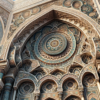You can contact us 24/7 +1 514 962 3011
$17.00
Subtotal: $17.00
Add $83.00 to cart and get free shipping!
Free Shipping on All Orders Over $100
$17.00
Subtotal: $17.00
Add $83.00 to cart and get free shipping!
Free Shipping on All Orders Over $100
The Rich Tapestry of Islamic Art
Introduction Islamic art is a window into a rich cultural and religious heritage that spans over 1,400 years. Characterized by its intricate geometric patterns, calligraphy, and absence of figurative imagery, Islamic art encompasses a wide range of mediums including architecture, painting, textiles, and ceramics. This article explores the unique characteristics, historical evolution, and contemporary significance of Islamic art.
Historical Context and Evolution Islamic art originated in the 7th century with the advent of Islam, but it quickly absorbed influences from the civilizations it encountered, like the Byzantine and Persian empires. Over centuries, it evolved into a distinct style known for its aniconism – the avoidance of images of sentient beings, in accordance with many interpretations of Islamic teachings.
Key Characteristics
- Geometric Patterns: Islamic art is renowned for its complex geometric patterns. These patterns are not only aesthetically pleasing but also carry deep symbolic meaning. They represent the infinite nature of Allah and the universe’s complexity.
- Calligraphy: Arabic calligraphy is a revered art form, often used to transcribe verses from the Quran. It symbolizes the verbal nature of Islamic revelation and is considered the highest form of artistic expression in Islamic culture.
- Arabesque and Floral Motifs: Arabesque, a form of artistic decoration consisting of rhythmic linear patterns of scrolling and interlacing foliage or plain lines, is another hallmark of Islamic art. These motifs symbolize the transcendent, infinite, and indefinable nature of God.
Islamic Architecture Islamic architecture, a prominent branch of Islamic art, includes some of the world’s most iconic structures like the Alhambra in Spain, the Blue Mosque in Istanbul, and the Taj Mahal in India. These structures are known for their ornate decorations, domes, minarets, and harmonious proportions, all reflective of Islamic artistic principles.
Influence and Contemporary Relevance Islamic art has influenced both Eastern and Western art over the centuries. In contemporary times, it continues to evolve, with artists exploring traditional themes and techniques in new, innovative ways. It’s a testament to the enduring legacy and adaptability of Islamic artistic traditions.
Conclusion Islamic art is not just a reflection of a religion but also of a rich cultural and historical landscape. It offers a unique perspective on the Islamic world’s diverse and dynamic cultural identity. Through its intricate designs and profound symbolism, Islamic art invites admiration and contemplation, transcending cultural and religious boundaries.
This article aims to provide an overview of Islamic art, emphasizing its historical development, distinctive features, and enduring impact on the cultural and artistic landscape.





